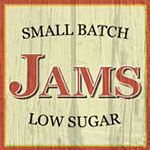Strawberries
Organic methods may help in producing more flavorful and nutritious food, but they are not the only secret to success. It is certainly possible to grow organic food that has only mediocre flavor.
We spend a lot of time thinking about how our berries and vegetables are going to taste.
Take our strawberries, for example. Many people confuse flavor and sweetness. ‘Flavor' is our interpretation of the volatile oils in the fruit. Sweetness is a pretty simple reaction to sugars in the fruit. Most strawberries on the market have a simple sweetness, but fall short on the much more complex volatile oils. We are looking to have both sweetness and flavor.
How do we do that?
- 1. We pick the fruit as ripe as possible, and get it to our customers as soon as we can. This is quite risky, because the riper a strawberry the softer it is, thus it is more susceptible to damage and spoiling.
- 2. We don't pump our plants with too much fertilizer, which would give us tons more fruit, but much less flavor in each berry. Organic methods help in this regard because our organic fertilizers release nutrients to the plant slowly.
- 3. We choose varieties that taste good. Unfortunately, those varieties invariably produce lower yields (and hence higher per-unit cost).
- 4. We build our soil. Rich soil offers the plant a wide range of nutrients resulting in a more complex flavor. Most strawberries are grown in sandy soils, which don't offer the plant much in terms of nutrients. They tend to have only slight, simple strawberry flavor.
- 5. We don't water too much. The extra water dilutes the flavor.
- 6. We don't give up. Of course, as weather conditions change, we get some variability in flavor. But we do everything we can to get the best flavor possible at the time of harvest.
We grow primarily two varieties of strawberry, the Chandler and the Seascape. We also try new varieties (actually old varieties) every year, always looking for the best flavor. Our favorite, the Chandler, is an old standby, but yields only about 2/3 as much as other varieties commonly available on the organic market. Nonetheless, we remain committed to this variety even though it is far less profitable to grow.
Produce
Olallieberries - These berries are a favorite of our U-pick customers.They are big, juicy and they make terrific jam and pie. Olallieberries are either a cross between a Youngberry and a Logan berry. Our U-pick olallieberries are ripe from the end of June through July.
Blackberries - We are experimenting with several varieties of these to find our favorites.
Tayberries - Named for the Tay River Region in Scotland where this Loganberry, raspberry hybrid berry was developed, the Tayberry has a deep red color and a very floral taste.
Loganberries - Developed in the Santa Cruz Mountains in 1883, the Loganberry is a cross of the Red Antwerp Raspberry and two varieties of blackberries. This cross resulted in a high yeilding, slightly tart berry which is perfect for baking and jams.
Boysenberries - The Boysenberry is a hybrid of Loganberry, blackberry, and raspberry. Originally grown by Rudolph Boysen, and first grown comercially by Walter Knott, this is a large, sweet, and dark berry.
Kiwis - Originally from China, this fruit grows vineyard-style and is perfect for U-pick in the late fall. Our location in a cooler climate means a longer ripening period, giving our kiwis a superior flavor. Our u-pick kiwis are available in November or December.
Artichokes - We stick to the old-fashioned Globe variety, which is a perennial plant from stock brought over from Italy many years ago. This variety is much more difficult to grow than the new varieties which are grown from seed, but have inferior flavor.
Broccoli - We selected our favorite variety, which has a deep green color and excellent flavor. It’s even popular with the kids. We have broccoli from July through February.
Cauliflower - Our cauliflower is rich and nutty in flavor. The season runs from July until February.
Pumpkins - We grow pie pumpkins for our made-from-scratch pumpkin pie. We harvest our Pumpkins in mid-October and into November, and sometimes bring them to market for a few months.
Peas - Occasionally the birds leave us with a few peas to sell. Nothing better!
Brussels Sprouts - Our delicious (yes, delicious!) brussels sprouts are usually in season from November through February.
Celery - Our extremely flavorful celery is ready mid-November, and runs until the end of January, and a little longer if we're lucky!










